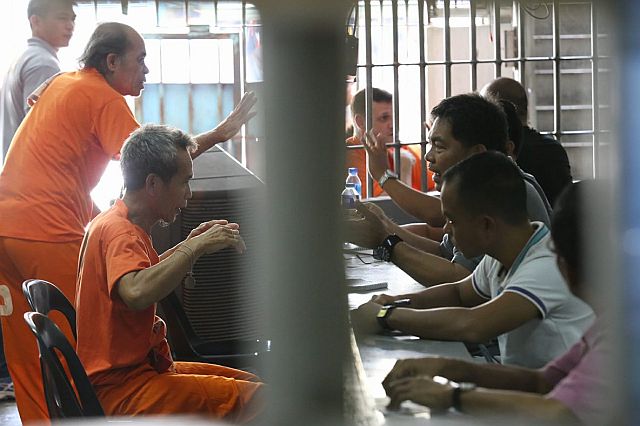
CHR personnel talk to prisoners on Friday to know if PDEA violated their rights when they were stripped naked during a surprise raid on Tuesday dawn. (CDN PHOTO/JUNJIE MENDOZA)
The Commission on Human Rights in Central Visayas (CHR-7) is conducting an investigation after inmates of the Cebu Provincial Detention and Rehabilitation Center (CPDRC) were stripped naked during a surprise inspection by the Philippine Drug Enforcement Agency in Central Visayas (PDEA-7) on Tuesday dawn.
CHR-7 chief investigator Leo Villarino said they receive a directive from the commission’s en banc to look into the incident and to find out whether the rights of the inmates were violated.
“They may be detainees but they still have the same rights as other human beings,” he told the Inquirer.
Accompanied by other investigators, Villarino visited the CPDRC at around 10 a.m. on Friday to talk with Roberto “Bobby” Legaspi, the officer-in-charge of the provincial jail.
Upon Legaspi’s approval, Villarino and the other CHR investigators talked to the inmates and ask if they felt offended or humiliated by PDEA’s action to strip them of all their clothings during the Greyhound operation.
“We are here to know if there really was a need to let the inmates remove their clothes? What did they want to achieve? We are here to ask questions on what really happened,” he said.
Under the United Nations’ Standards for the Treatment of Prisoners, Villarino said stripping prisoners off their clothes are allowed for security purposes during jail raids.
“But in the stripping naked of prisoners, intrusive searches are strictly prohibited,” he said.
Intrusive searches, he explained, involved “going into or touching the cavities or crevices of the body.”
Villarino said he understood the decision of PDEA-7 to let the inmates remove their clothes.
“We know how innovative our inmates are. We know for a fact that illegal items are placed inside the inner parts of the body,” he said.
Villarino said they just want to know if the inmates’ rights were violated. The CHR investigator also questioned the decision of some media entities to publish the photos of the naked inmates.
Villarino said he intends to hold a dialogue with mediamen to explain some protocols.
“Photos of gory photos of dead people are blurred. Why don’t we use the same protocol for inmates who are still alive?,” he said.
After the investigation, Villarino said they hope to come up with clear guidelines on the conduct of inspections inside the jail.
PDEA-7 Director Yogi Filemon Ruiz said he welcomed any investigation conducted by the CHR.
“I take full responsibility of what happened. I better face criticisms than having one of my agents get stabbed by the inmates,” he said in an interview.
Ruiz said law enforcers had to protect themselves from inmates who may have wanted to attack them using bladed weapon hidden beneath their shirts or pants.
During the Greyhound operation last Tuesday, they confiscated a total of 68 bladed weapons at the CPDRC.
“That action (for prisoners to remove their clothes) was a mutual protection for both the agents and the inmates. If they are not wearing anything, then we’re sure that not a single bladed weapon is hidden from us. It was a judgement call on my part to let them remove their clothes,” he said.
CPDRC currently has about 3,600 inmates. During the raid, Ruiz said there were only 289 agents of PDEA, policemen, and army. Compared to the number of inmates, he said law enforcers had to assert themselves otherwise they might be overpowered by the inmates.
Ruiz clarified that only the male inmates of CPDRC were asked to remove their clothes.
“The female detainees were just frisked by female agents of PDEA and were asked to stay in one area far from the male detainees,” he said.
“I don’t think we violated the rights of the prisoners. The search was done in a peaceful and orderly manner. We didn’t humiliate the inmates. If ever there are those who interpret what we did as degrading the inmates, then I apologize. But there really was no intention to do so,” he added.
Ruiz added that he did not even call the media during the actual jail inspection in order not to violate the privacy of the inmates.